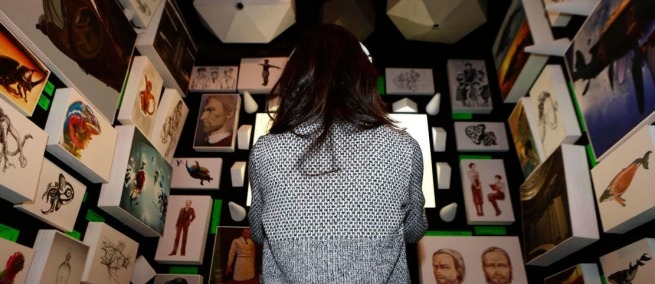
The Museum of the Moving Image’s Associate Curator of Film—Eric Hynes—is covering the 2016 Sundance Film Festival from Park City, Utah. Sundance’s New Frontier section showcases transmedia storytelling, multi-media installations, performances, and films. On its 10th anniversary, Hynes explored inside the New Frontier showcase. He writes:
“Yesterday morning between the hours of 9 and 11 A.M, I traveled to Cuba, visited the set of Star Wars: The Force Awakens, experienced a city under air attack, endured solitary confinement, walked a narrow path over a blazing, infinite abyss before cradling a mysterious orb in some futuristic, alien land, roved around Mars, and became an exotic, endangered creature floating above a rain forest – for starters. And yet it felt like I had barely begun to explore the many modes of transportation and reinvention at this year’s New Frontier showcase, which celebrates its 10th anniversary of presenting cutting edge media and fine art during the Festival.
“To say that interactive media has transitioned into a virtual terrain would be an understatement, as not only is this latest iteration of New Frontier dominated and defined by experimentations with virtual reality, the sheer number of VR experiences – nearly 40 works, numerous of which involve the navigation of physical space and objects –presents a critical mass without precedent. When VR started popping up in New Frontier just a few years ago, it was all about potential and possibility. With new avenues still being forged, there still does seem to be boundless potential, but we’re also solidly in the kinetic era. Some forms and standards have taken shape. Genres have developed, including fantasy, documentary, educational, music video, avant garde. A consensus has gathered around running times of between 3-6 minutes. And there are artists, designers, developers, and filmmakers with deepening experience with VR and multiple appearances at New Frontier, such as Lynette Wallworth (back this year with Collisions), Danfung Dennis (Condition One), Nonny De La Peña (Kiya, Across the Line), Rose Troche and Morris May (Perspective, Chapter 2: The Misdemeanor), Chris Milk (Waves of Grace), and others. There are exhibits and installations, but there are also experiences designed to be viewed at home and on smart phones, via established portals such as Google, The New York Times, the Associated Press, and the Guardian. This year VR isn’t just here, it’s everywhere.
“Thanks to the participation of filmmakers such as Dennis and Lucy Walker, whose A History of Cuban Dance is precisely and infectiously what the title describes, VR is growing beyond merely celebrating technology and toward offering a tool for compelling image making. When Walker places the 360 camera on the windowsill of a dance studio, or in the back corner seat of a classic car cruising through town, the experience becomes more than about our placement in these environments—it’s about an artist offering a perspective on them. Similarly, the Guardian’s initial foray into VR—6x9: An Immersive Experience of Solitary Confinement—benefits from a journalistic thoroughness and knowledge of subject. Francesca Panetta and Lindsay Poulton’s work translates the mission of written and video reportage into a 360 degree, CGI-generated, 6-minute realm, where information, emotion and physical sensation coalesce into a powerful expression of empathy and urgency.
“Other works follow more of an escapist impulse, such as Real Virtuality: Immersive Explorers, which combines VR with motion capture, virtual with actual objects. The work transports you to several fantastical environments, including a Blade Runner-like futuristic city, and the aforementioned pathway above a firey abyss, which buckled my knees, and sent my fellow player toppling as she tried to brace herself against a virtual, i.e. physically nonexistent, wall. The impulse may be escapist, but the experience can be actual, consequential. Traveling further into four-dimensional presentation brings us to In the Eyes of the Animal, which employed optics and headphones embedded in a large, heavy, earthen helmet, which the user cradles in his or her hands, adjusting as desired, while simultaneously wearing a backpack that vibrates and hums for further effect. But it’s the visualization of the piece that blew me away, offering a wondrously abstract counterpoint to the physical demands of the apparatus.
“Aiming to offer the experiential POV of several unidentified British animal species, creators Marshmallow Laser Feast (Barnaby Steel and Robin McNicholas) don’t attempt photographic or CGI resemblances to the natural world, but rather play with the possibilities of digitization. Pivoting around in that bulky headset, imagery gathers and disperses according to where you look, suggesting a lack of peripheral vision but also offering a beautiful evocation of partial, focused, fleeting sight. It’s like a Pointillist painting cellularly disassembled and assembled again, anew, with your own head and eyes as the instrument of creation. You’ve been transported to a previously unseen world, but you’re also making a new one, over and over. You’re not just subject to an experience, you’re the author of one. As New Frontier embarks on its second decade, In the Eyes of the Animal offered an ideal metaphor for the terrain already traveled, and the unknown distances that lay ahead.”
The Museum of the Moving Image has a new series VR360 which explores the impact of VR on culture and creativity.
PARTNERS